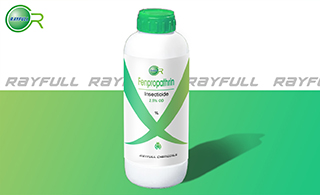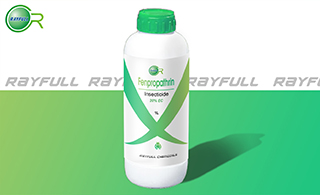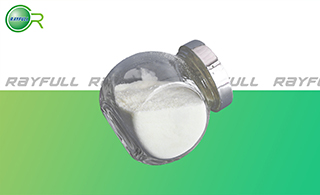Fenpropathrin
    甲氰菊酯 甲氰菊酯
Introduction: Fenpropathrin is a pyrethroid (type 1) insecticide. A pyrethroid is a synthetic chemical compound similar to the natural chemical pyrethrins produced by the flowers of pyrethrums (Chrysanthemum cinerariaefolium and C. coccineum). Pyrethroids are common in commercial products such as household insecticides and insect repellents. In the concentrations used in such products, they are generally harmless to human beings but can harm sensitive individuals. They are usually broken apart by sunlight and the atmosphere in one or two days, and do not significantly affect groundwater quality except for being toxic to fish. Insects with certain mutations in their sodium channel gene may be resistant to pyrethroid insecticides.
Common name: Fenpropathrin
Another name: Meothrin; Danitol; Rody; Meiothrin; Miothrin; Danimen; Herald; Kilumal; Smash; FENPROPANATE; Danitol Fiori; etc.
Chemical name:
(RS)-α-cyano-3-phenoxybenzyl 2,2,3,3-tetramethylcyclopropanecarboxylate
Empirical formula: C22H23NO3
Structural formula:

Mol. Weight: 349.42 g/mol
CAS No.: 39515-41-8
Specifications
Leading Fenpropathrin supplier
Fenpropathrin 92% TC
Fenpropathrin 95% TC
Fenpropathrin 20% EC
Fenpropathrin 2.5% OD
Packing:
BULK PACKING
Powder: 25kg/Bag, 25kg/Drum, 50kg/Drum etc.
Liquid: 200L/Drum, 20L/Drum, 10L/Drum etc.
SMALL PACKING
Powder: 1kg/Alu bag, 500g/Alu bag, 200g/Alu bag, 100g/Alu bag, 50g/Alu bag, 15g/Alu bag etc.
Liquid: 5L/Drum, 1L/Bottle, 500ml/Bottle, 250ml/Bottle, 100ml/Bottle, 50ml/Bottle etc.
Customerized packing label
Fenpropathrin FAO standard
Professional registration
HAZARDS IDENTIFICATION
Hazard statement(s)
H301: Toxic if swallowed.
H312: Harmful in contact with skin.
H330: Fatal if inhaled.
H400: Very toxic to aquatic life.
H410: Very toxic to aquatic life with long lasting effects.
Precautionary statement(s)
P260: Do not breathe dust/fume/gas/mist/vapors/spray.
P264: Wash ... thoroughly after handling.
P270: Do not eat, drink or smoke when using this product.
P271: Use only outdoors or in a well-ventilated area.
P273: Avoid release to the environment.
P280: Wear protective gloves/protective clothing/eye protection/face protection.
P284: [In case of inadequate ventilation] Wear respiratory protection.
P301+P310: IF SWALLOWED: Immediately call a POISON CENTER/doctor/...
P302+P352: IF ON SKIN: wash with plenty of water.
P304+P340: IF INHALED: Remove victim to fresh air and keep at rest in a position comfortable for breathing.
P312: Call a POISON CENTER or doctor/... if you feel unwell.
P405: Store locked up.
P501: Dispose of contents/container to.
Supplemental Hazard Statements: none.
MAMMALIAN TOXICOLOGY
Acute toxicity: 1) Acute oral LD50 for rats is ≥ 48.5 mg/kg bw (vehicle dependent). 2) Acute dermal LD50 for rats is ≥ 870 mg/kg bw (vehicle dependent). 3) Acute inhalation toxicity LC50 (4 h) for rats is ≥0.556 mg/L (nose-only exposure). 4) Skin irritation: Slightly irritating to skin (rabbits). 5) Eye irritation: Slightly irritating to eyes (rabbits). 6) Skin sensitization for guinea pig: Non-sensitizing.
NOEL: (2 y) for rats is 7.1 mg/kg/day, (2 y) for mice is 56 mg/kg/day, (1 y) for dogs is 3.1 mg/kg/day. Other Not carcinogenic. Not genotoxic.
ADI (JMPR) 0-0.03 mg/kg b.w. [1993, 2012]
Classification:
WHO Classification: II (Moderately hazardous)
EC Risk Classification: T+ - Very toxic: R26; T - Toxic: R25; Xn - Harmful: R21; N - Dangerous for the environment: R50, R53
US EPA Classification (formulation): II (Warning - Moderately toxic)
ECOTOXICOLOGY
Effect on birds: Acute oral LD50 for Mallard is 1089 mg/kg. Effect on fish: Acute LC50 (96 h) for Rainbow trout is 0.0023 mg/l. Effects on aquatic invertebrates: Acute EC50 (48 h) for Daphnia magna is 0.00053 mg/l. Effects on algae: Acute 72 hour EC50 is 2 mg/l. Effects on bees: Contact acute 48 hour LD50 is >0.05 μg/bee. Effects on earthworms: Acute 14 day LC50 is 184 mg/kg.
ENVIRONMENTAL FATE
Soil/Environment Degraded principally by photolysis, DT50 2.7 w in river water. Duration of activity in soil c. 1-5 d.
Usage: Fenpropathrin was developed by Valent USA. It is an acaricide and insecticide used to control many species of mite and other insects.
Application: Biochemistry Acts on the nervous system of insects, disturbs the function of neurons by interaction with the sodium channel. Mode of action Acaricide and insecticide with repellent, and contact and stomach action. Uses Control of many species of mites (except rust mites) and insects (e.g. whitefly, lepidopterous larvae, leaf miners, leafworms, bollworms, etc.) on pome fruit, citrus fruit, vines, hops, vegetables, ornamentals (including ornamental trees), cotton, field crops, and glasshouse crops (cucurbits, tomatoes, ornamentals, etc.).
| 






